 TRIZ
Technical Report
TRIZ
Technical Report |
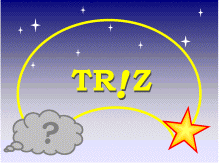  
|
Software
Tools for TRIZ
-- Mechanism,
Usage, and Methodology Learning -- Invention Machine's TechOptimizer
Pro Version 2.5 |
Toru Nakagawa
(Osaka Gakuin Univ.)
June 7, 1998 (in Japanese) |
Originally
written in Japanese as an internal manual in Fujitsu Laboratories Ltd.
on Jan. 29 and Feb. 12, 1998.
First Published
in the ITD/TRIZ home page of Mitsubishi Research Institute on July 3, 1998.
Published
in this "TRIZ Home Page in Japan" on Nov. 2, 1998 (in Japanese).
English
translation by Toru Nakagawa and published here on Feb. 25, 1999. |
Preface for the English
version (Toru Nakagawa, Feb. 25, 1999)
This technical
report was originally written in Japanese as a hand-made manual of TechOptimizer
Pro V2.51
for promoting TRIZ in Fujitsu Laboratories Ltd. Then it was re-edited
in the HTML
form and published
in the WWW page of Mitsubishi Research Institute, and later in the Japanese
page of this
"TRIZ Home Page in Japan". This report intends to be a self-training
manual for the
novice users
of TechOptimizer, who often know little about TRIZ but are already trained
in some
field of engineering.
By using the software tool step by step, or rather by reading the materials
in the software,
the users can learn a lot about the TRIZ methodology. As a consequence
of this
intention,
users are guided to use various modules/functions of the tool in the almost
reverse order
officially
given in the training seminars by Invention Machine Corporation.
(Please refer
to the present author's "Introduction to TRIZ" as well.)
In this report,
more than 20 figures are shown in the form of actual displays of the tool.
The
present author
wishes to thank Invention Machine Corporation and Mitsubishi Research Institute
for thier
permissions. These figures are indispensable for making this technical
report vivid and
understandable
even for the people who do not have an access to the software tool.
By now, TechOptimizer
Pro is marketed with Version 3.0 (and Version 3.0J in Japanese) having
some new functions
and extended databases. I am going to update this technical report
in the near
future. Nonetheless, I believe the English translation of this technical
report would be
helpful for
many people in the world who are trying to introduce the TRIZ methodology
(and its
software tool)
in their practice in industry.
Preface
(Toru
Nakgawa, June 7, 1998)
The software tool described in this
technical note is Invention Machine Corporation's
"TechOptimizer Professional Edition
Version 2.5" (i.e. microelectronics-enhanced
version). The present author,
during his former work at Fujitsu Laboratories Ltd,
introduced and used this software
for the evaluation purpose, learned its mechanism by
himself, and wrote a home-made manual
of it for novice users to learn the usage of the
tool and its background methodology
(Jan. 29 and Feb. 12, 1998). The manual has been
edited into the present technical
report in an HTML format.
The author appreciates it much that
Mitsubishi Research Institute (as the general agency
in Japan for Invention Machine Corporation)
has kindly allowed to cite here over 20
displays of the software tool in
its actual usage. Illustrations of these displays have made
this note vivid and useful even
for those who do not have the tool yet to understand the
usage and effectiveness of the tool.
TechOptimizer Pro V2.5 is the most
up-to-date (at the time of January 1998) among the
TRIZ methodology tools that are
currently commercially available. This software installs
a wide range of databases compiled
through the analyses of science and technology
references and patents, and implements
the TRIZ methodology to retrieve the databases.
However, the user manual and the
training materials offered by IMC describe the
operation methods and the usage
of the tool in their standard way which seems suitable
only for well-trained people; thus
they do not fit well to the needs of novice users who
want to learn the TRIZ methodology
itself through the use of the tool.
The present technical report, on
the other hand, describes the software tool from the view
point of novice users. How
are the software tool and its databases organized? How does
it work? How can we learn
its usage? How we should use it? etc. Consequently, this
report demonstrates a new
way of learning the TRIZ methodology itself in its depth and
width by using the software tool
"TechOptimizer".
1.
Overview of the structure of TechOptimizer Pro V2.5
TechOptimizer is composed of five
modules. Invention Machine Corporation usually
shows them in the following order,
along the "procedure of problem solving".
| TechOptimizer Module: |
Problem analysis, trimming,
problem definition |
| Principle Module: |
Examples of techniques, examples
of contradiction solving |
| Prediction Module: |
Examples of application trials for
problem solving |
| Effects Module: |
Explanation of technical principles |
| Feature Transfer Module: |
Transfering features from one system
to another |
For novice users, however, it is
difficult to learn TechOptimizer and the TRIZ
methodology in this order.
Users often get frustrated at the first step of using
TechOptimizer Module. This
is becasue the users cannot see merits of using
TechOptimizer and cannot utilize
their own technical expertise and problem solving
approaches which they have already
mastered.
The present report is based on the
understanding that this software tool has installed the
technology knowledgebases of the
world in a systematic way based on the TRIZ'
philosophy, and that the retrieval
scheme in TRIZ naturally matches the needs of users
for their technical problem solving.
As the consequence, this report presents the software
tool and its usage in a manner to
expand the users' ordinary problem solving approaches
towards higher TRIZ approaches and
hence to guide the users to get familiar with the
TRIZ methodlogy while learning the
software tool. The outline of this report is as
follows:
2. To learn the trends
in technology evolution (Prediction Module: Part 1. Trends)
3. To learn the system
of science and technology from a practical viewpoint (Effects
Module: Part 1. Effects and Examples)
4. To learn various
methods for implementing technological goals (Effects Module:
Part2. Functions)
5. Various methods
for improving the user's system (Prediction Module: Patr 2.
Method tree)
6. To learn the 40
"Principles of Invention" (Principles Module: Part1. Principles and
Examples)
7. To obtain suggestions
of principles of invention for solving user's contradiction
(Principle Module)
8. To describe the
outline of the user's system in a problem (TechOptimizer Module,
Part 1, Basic part)
9. To functionally
analyze the user's system (TechOptimizer Module: Part 2. Functional
Analysis)
10. To examine the
functional analysis of the user's system (TechOptimizer Module:
Part 3. Trimming; and Feature Transfer Module)
11. To record the process
of problem solving and the ideas obtained (Recording and
reporting function)
12. Conclusion
2.
To learn the trends in technology evolution
(Prediction Module: Part 1. Trends)
To the users who start using this
software tool or want to learn it, the present author
advises first to learn the displays
of the trends of technical system evolution implemented
in the [Prediction Module].
[Operation:
Start the [TechOptimizer Pro], go to [Prediction Module], and then click
the
icon of the
[Trends] database. The index to the
database is displayed (see Fig.
2.1) .
Then you can
read the 20 trends one by one by clicking the icon in this index.]
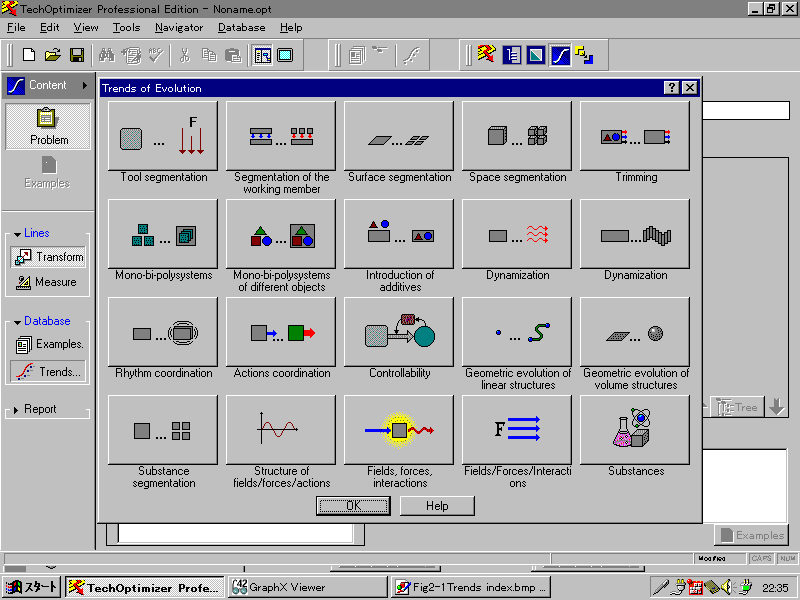
Fig. 2.1
Display of the index of the [Trends] installed in [Prediction Module]
On contrary to the implemented order
of the 20 trends, users are advised to read the last
display first; i.e. No.
20: the [Substance] display, shown in Fig.
2.2. As the states of
substances, we usually think of
the "three states", i.e. solid, liquid, and gas, which are
taught as idealized concepts.
TRIZ, however, lists up many more states, including
powdery, porous, and foam, from
the practical viewpoints for technology development.
The description in the display is
helpful for us to recall transformations among the states
of substances and also substances
with typical or peculiar characteristics.
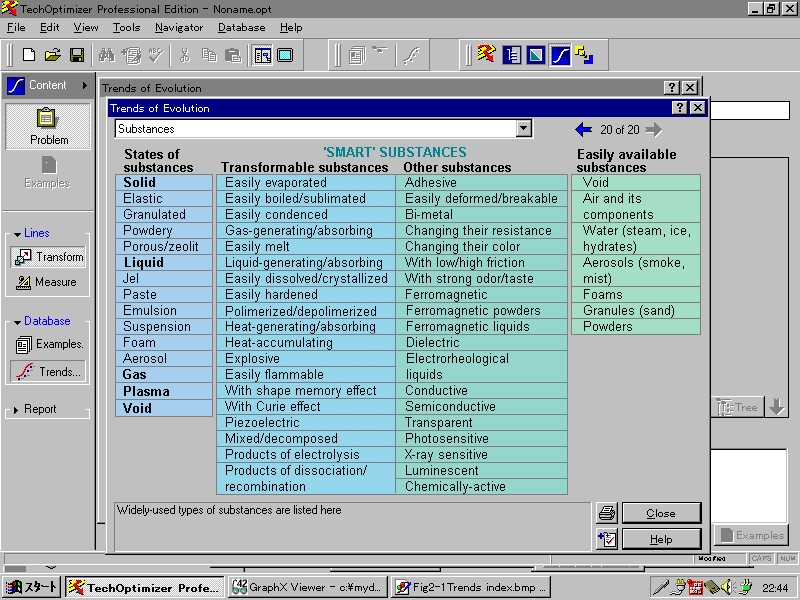
Fig. 2.2
Display of [Trends] No. 20 in [Prediction Module]: [Substances]
Next you are recommended to read
the display No. 19, i.e. [Fields/Forces/Interactions]
(see Fig.
2.3). This display summarizes mechanical forces in various
forms,
electrical/magnetic/electro-magnetic
fields and interactions, thermal interactions, etc.
The term "Fields" in TRIZ represents
the whole body of forces, fields, and interactions as
listed in this display. (For
example, in the "Su-Field Analysis" of TRIZ, a user's
technical system is analyzed and
formulated simply in a scheme containing two objects,
i.e. substances, and an interaction,
i.e. "Field", between them. )
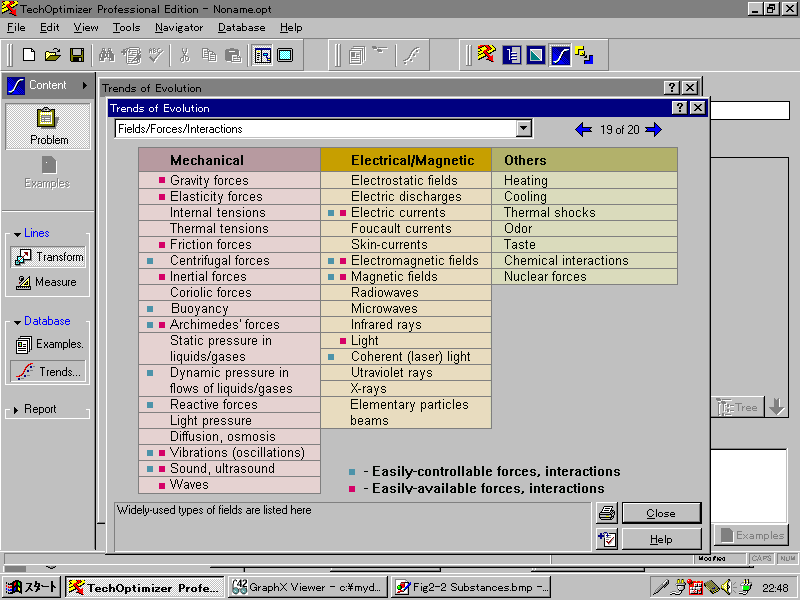
Fig. 2.3
Display of [Trends] No. 19 in [Prediction Module]: [Fields/Forces/Interactions]
The No. 18 display of [Trends], i.e.
[Fields,
forces, interaction transformations], as
shown in Fig.
2.4, is also a very interesting summary. Concerning the fields,
forces, and
interactions mentioned above, this
display summarizes the generation, conversion,
structue change, and accumulation
of them. In the column of "conversion", it shows that
the "Fields" of the five main categories
(i.e. mechanical, electrical, magnetic, thermal,
and optical "Fields") can be interconvertible
by use of some proper setting-ups of
"substances". Also it shows
that we can structurely change these "Fields", in various
ways (including increasing/decreasing,
reflecting, refracting, defracting,
standing/traveling wave, etc.),
by using optical cases for illustration. All these "Fields"
can be accumulated in various forms,
including kinematic energy, electrical energy,
chemical energy, etc. This
display (Fig. 2.4) gives us excellent and
insightful viewpoints
to review and reorganize our knowledge
of science and technology for the purpose of
effectively using them in practice.
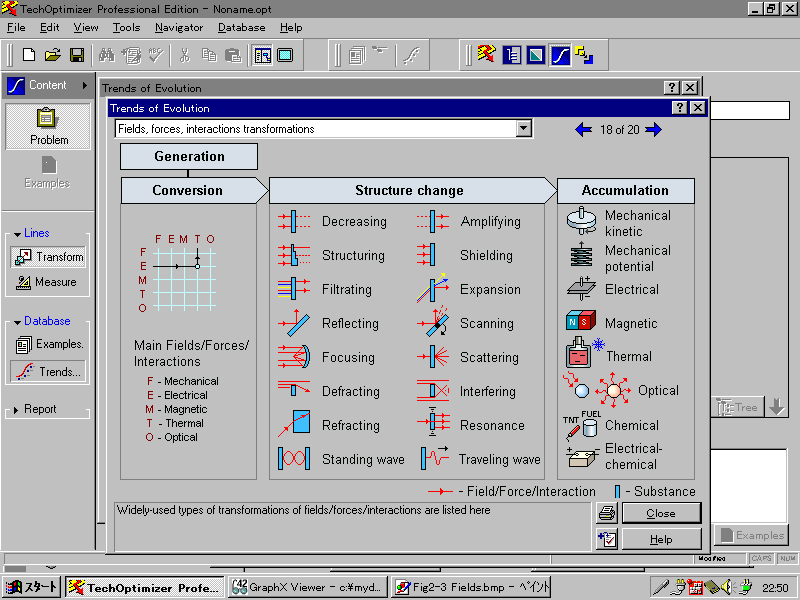
Fig. 2.4
Display of [Trends] No. 18 in [Prediction Module]: [Fields, forces,
interaction transformations]
On the basis of such understanding
of the TRIZ philosophy, users are advised to read the
displays of the [Trends] No. 1 through
No. 17 one by one. As an example, here we cite
the [Trend]
No. 2, i.e. [Segmentation of the working member], in Fig.
2.5. This display
shows that the working part of a
technical system is segmented into smaller ones as one
general trend in the evolution of
technical systems. A monolithic part is segmented into
smaller parts, into powder/paste/gel,
into gas, and finally into parts using a "Field". This
trend is illustared by the example
of the evolution of ball bearing; from a metal ball
bearing, into gas bearing, and finally
into a magnetic bearing system. For an non-expert
of this field like the present author,
the example here is somewhat too nice to be
practical, but experts of the field
regard this as natural and already established
technologies. By clicking
the icon of each evolution step in the display, one can read
short explanation of the step at
the bottom of the display. These trends are extracted
from the anayses of a large number
of patents, and formulated into a pattern which has
appeared many times in varous fields
and various systems. It is advised to users that you
should consider your own system
in terms of these trends and to locate it in the trends of
general evolution. The full
list of the trends is shown in Fig. 2.1.
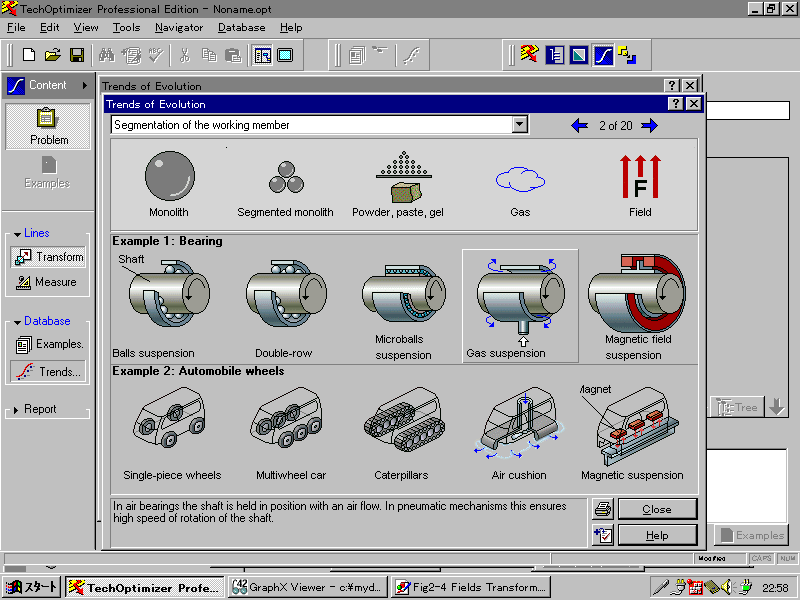
Fig. 2.5
Display of [Trends] No. 2 in [Prediction Module]: [Segmentation of
the working member]
Other functions of [Prediction Module]
are discribed in Section 5.
Last updated
on Feb. 25, 1999. Access point: Editor: nakagawa@utc.osaka-gu.ac.jp